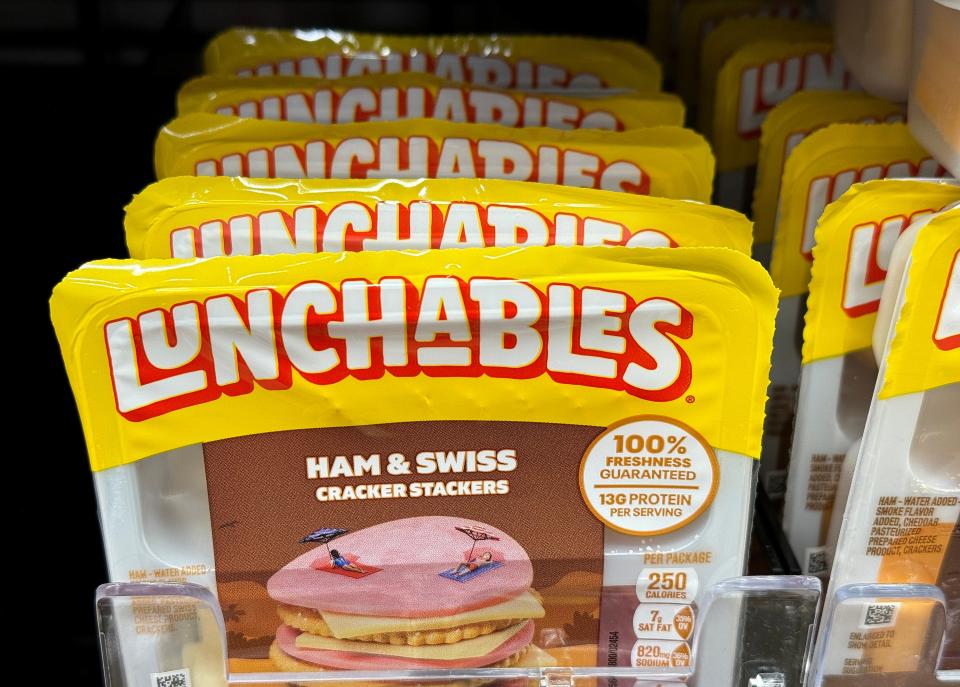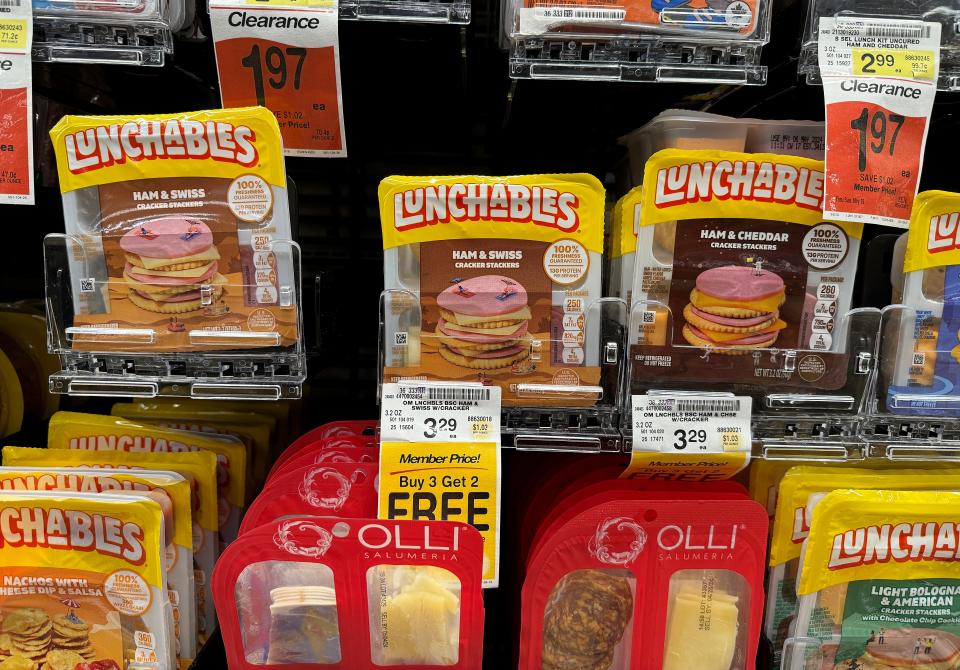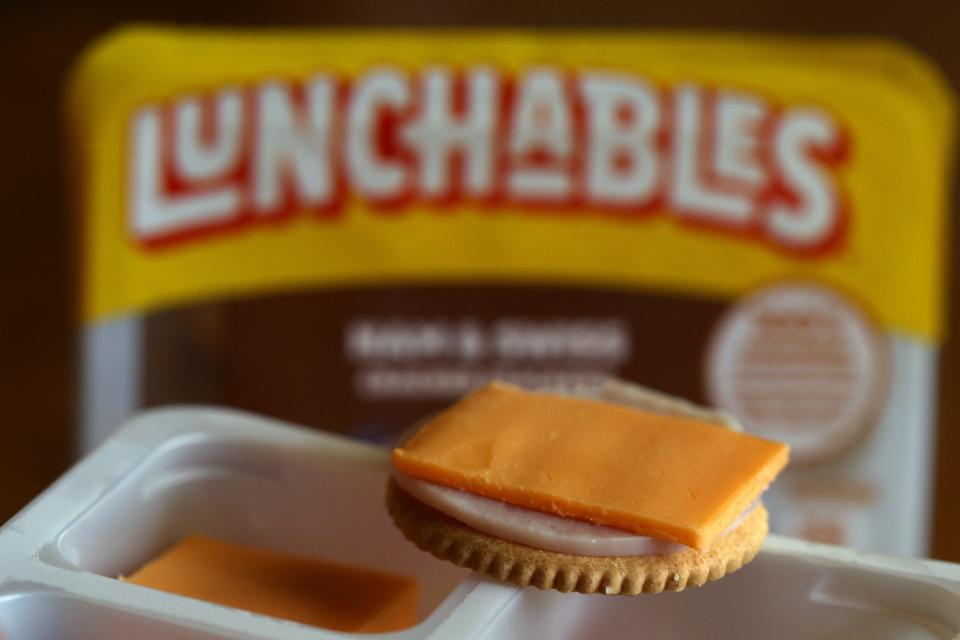Is there lead in Lunchables? What to know after Consumer Reports released guidance to USDA
Lunchables are "stackable as they are snackable," according to the website for the prepackaged meals, but a recent report is causing some parents to doubt whether their children should be eating them.
Consumer Reports called on the U.S. Department of Agriculture on Tuesday to remove Lunchables from the National School Lunch Program because of "higher levels of sodium" and "high levels of lead" in the food kits.
“Lunchables are not a healthy option for kids and shouldn’t be allowed on the menu as part of the National School Lunch Program,” Brian Ronholm, director of food policy at Consumer Reports, which launched a petition to the USDA, said in the release. “The Lunchables and similar lunch kits we tested contain concerning levels of sodium and harmful chemicals that can lead to serious health problems over time."
Here's what to know.

Lead contamination: Recalled applesauce pouches linked to single cinnamon processor: FDA
Kraft Heinz says Consumer Reports study that found high levels of lead, sodium in Lunchables is 'misleading'
In a statement emailed to USA TODAY on Thursday, Kraft Heinz, owner of Lunchables, said: "We are extremely disappointed with the reporting from Consumer Reports and believe the results of their study are misleading, causing undue concern over the safety of our products.
"The fact is that all Lunchables products meet strict safety standards set by government agencies," Kraft Heinz said. "Consumer Reports admits that none of the food they tested exceeded any legal or regulatory limits, but they chose to bury that fact."
In Consumer Reports' reporting on metals, the results of the study are based on California's maximum allowable dose for heavy metals, the Chicago, Illinois-headquartered food company said. All Kraft Heinz's products, including Lunchables, "tested well below the acceptable limits," according to the company.
"The metals they focus on are naturally occurring, and thus low levels may be present in any food product," Kraft Heinz said. "We do not add these elements to our products."
'Lunchables adhere to all USDA standards', Kraft Heinz says
Kraft Heinz maintains that the "National School Lunch Program-approved Lunchables adhere to all USDA standards," according to the statement.
"We increased the amount of meat in the products to increase protein levels and help fuel kids throughout the day," the food company said. "With more meat comes naturally elevated levels of sodium to ensure safe preservation of the product. It’s worth reiterating that Consumer Reports did not test our school products."
Kraft Heinz said it is proud of the product.
"By offering Lunchables in schools, we’re able to help meet schools’ needs by giving them affordable, convenient solutions that provide students with quality nutrition at lunchtime," the company said. "We’ve received feedback that products like Lunchables are more trusted by school administrators due to our strict food safety and quality guarantee. We see our work with schools as a solution to valid struggles schools may face."
Are Lunchables being recalled?
Lunchables have not been recalled. Consumer Reports is suggesting to the USDA that the snack kits be removed from the National School Lunch Program.
Kraft Heinz would have to voluntarily initiate a recall of Lunchables, according to the Food and Drug Administration.
In some situations, the FDA can request or mandate a recall, but the federal agency has not done so for Lunchables. If it did, any violation could be corrected and Lunchables would return to the marketplace, according to the FDA's website.
Lunchables also do not appear on the FDA's enforcement reports for April.
Are Lunchables healthy?
Maya Feller, a registered dietitian and nutritionist who worked with New York City Public Schools, said she's concerned about the "regular inclusion of Lunchables and Lunchable-type kits" because they're not "nutrient-dense options" for students, according to an interview with ABC News.
"The high sodium content is definitely of concern, especially from a young age," Feller said. "The health risks associated with high and chronic consumption of added salts are well documented."

From Feller's clinical experience, she would like to see more "nutrient-dense plant-forward options" in schools, especially meals with less added sugars, saturated fats and added salts, ABC News reported.
Though many may be skeptical of picking up a Lunchable, the FDA says, it is "not possible to completely prevent lead from entering the food supply."
Although it's impossible to prevent lead in food, it is food manufacturers' legal responsibility to "significantly minimize or prevent chemical hazards when needed," according to the FDA.
When did Lunchables come out?
Lunchables were introduced in 1988 as simple packages of meat, cheese and crackers, according to a Washington Post article in 1999.
Over time, other variations of Lunchables have been released, including Pizza Swirls and Pizza Dunks, hot dogs, hamburgers, tacos and nachos, The Post reported.

Who owns Lunchables? When were they invented?
Kraft Heinz, a food company formed in 2015 through the merger of Kraft Foods Group and H.J. Heinz Holding Corp., owns Lunchables.
Lunchables are marked under Oscar Mayer, the original creator of the snack kits in 1985, according to journalist Michael Moss's 2013 book titled "Salt Sugar Fat: How the Food Giants Hooked Us."
How much are Lunchables?
Lunchables vary in price depending on where they're bought, but most single kits cost less than $2.
Walmart is selling most of its single Lunchables kits for $1.87, according to the store's website.
Target is selling its Lunchables single kits for $1.99, according to the retailer's website.
Lunchables kits with their "100 percent juice" can be a little pricier, but are still around $3 at most stores.
This article originally appeared on USA TODAY: Lead in Lunchables? What to know about Consumer Reports findings

